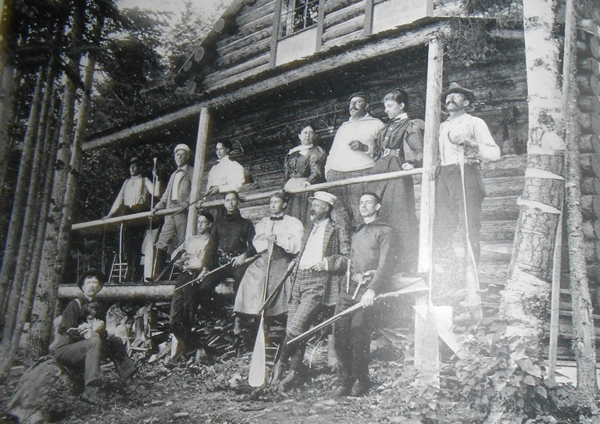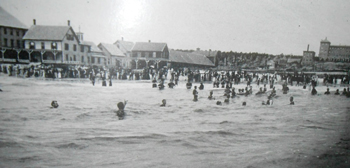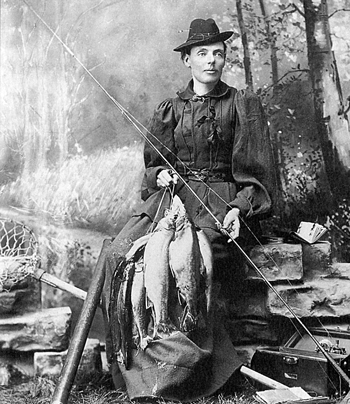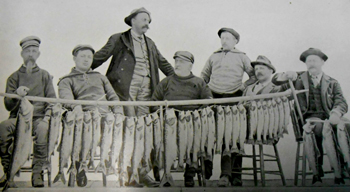Selling Maine
The Beginning of Maine’s Tourism Industry
by Tom Seymour

C.S. Cook’s Camps on Birch Island, Holeb Lake, Southwest of Jackman. Note well-prepared sport standing on the ground far right with rifle and pistol and knife in his belt. The Bangor and Aroostook Railroad brought tourists to remote western Maine.
Old Orchard Beach has the distinction of being the first part of Maine that was advertised as a vacation destination.
According to Harrie B. Coe in his 1928 book Maine, A History, this was in 1850 and the advertising was just a small flyer, an inauspicious beginning for what would become one of the state’s most important industries, the tourist industry.
Not long after that in 1855, artists from other states discovered the natural beauty of Mount Desert Island. Ten years later, the Town of Bar Harbor became a favorite gathering spot for socialites. The first summer cottage vacation home was built in 1867 and soon after came the summer palaces and mansions of the rich and famous.

Swimming at Old Orchard Beach. Railroads brought tourist to Maine locations before the automobile opt roads to drive them on. Railroads promoted tourism to fund their rail line building.
Advertising for Bar Harbor and Mount Desert Island has continued, unabated, since the beginning. The close proximity of Acadia National Park to the Town of Bar Harbor strengthened the town’s blue-ribbon standing as a tourist destination. Advertisements for the area came in many forms, from magazine ads to placemats and postcards.
Today, beginning in spring and continuing through autumn, a steady stream of Acadia-bound vacationers from every state swells the number of vehicles heading northeast on U.S. Route 1. And businesses along Route 1 follow the same seasonal pattern, opening in spring and closing in late fall. Maine’s tourist industry has become one of the state’s most valued industries, right along with woods products and commercial fishing.
Railroad Tourism
In the days before automobiles, horse-drawn conveyances, boats and railroads were the only modes of travel. Railroads were a natural tie-in with the fledgling tourist industry. To that end in 1884, the Maine Central Railroad began its summer tourist business. That was when railroad man Payson Tucker devised the catchy slogan, “Maine, The Nation’s Playground.”
This thirst to develop and profit from vacationers to Maine led to implementation of several runs designed specifically for tourists. One of the first and a very popular train trip was the Boston to Mt. Desert Ferry run. Visitors, upon reaching their destination, disembarked from the train and continued the balance of their trip to Bar Harbor on the ferry. This wedding of train and ferryboat made it possible to reach wilderness destinations that were otherwise only accessible by foot or horseback.
Sportsmen, in particular, immediately appreciated the possibilities that train travel could afford. Most rail lines were sportsman-friendly and anglers and hunters could hop on the train in any one of a number of towns and get off at any good-looking spot. Arrangements were made for these persons to meet the train later for the trip back home.
A well-written and still popular book, Nature I Loved, by Bill Geagan, brought the beauty, glamour and timeless solitude of Maine’s wild areas to a wide number of readers. Geagan, a young man at a crossroads in his life (he eventually became a newspaper man, spending much of his working life with the Bangor Daily News) wrote about taking a train to Hermon Pond in Hermon, Maine, and spending a summer in a cabin on the pond’s shore.
This was during a time when Hermon Pond was difficult to reach because of being isolated. In addition to the cabin where Geagan stayed, an old Maine woodsman occupied the only other structure on the lake. This was directly across the pond from Geagan’s place.
Although out of print, used copies of Geagan’s book are available from many online sources. Its popularity has not noticeably diminished despite the passage of time.

Fly Rod Crosby, nationally known sport fishing writer and sportswoman, wearing the fishing clothes she designed and made. This photo is believed to have been taken at the same time as one published in New York’s Shooting and Fishing magazine in December, 1894. The magazine carried, “Field Sports for Women” by Fly Rod Crosby. Photo courtesy the Maine State Museum, Augusta, Maine.
First Guidebook
A pioneer in the tourist industry, Payson Tucker owns the distinction of having published the first guidebook for Maine destinations. Places of interest included Old Orchard Beach, Bar Harbor, the Rangeley region and the Moosehead Lake region. These were all places served by the railroad and of them all, two were and still are, popular sporting destinations.
So while Payson Tucker was a prominent advocate of tourism, he was not the only Mainer out there promoting the Pine Tree State. Cornelia “Fly Rod” Crosby appeared in the Maine exhibit at the second annual Sportsman’s Exposition held in Madison Square Garden in New York City in March of 1896.
Crosby, a celebrated angler, hunter and journalist, enthusiastically promoted Maine as a tourist destination, but in this case, a destination for visiting anglers and hunters. As a youth Crosby was sickly and the suggested cure from her doctor involved spending as much time as possible in the outdoors, breathing in the fresh air.
So finding herself in a farmhouse near the base of Mt. Blue, Fly Rod Crosby threw herself into the cure process and began exploring and learning about nature. Crosby also caught her first trout from a mountain stream that coursed down the mountain. But instead of using a fly rod, the future fly-rodding legend took her first fish on an angleworm fished with an alder pole.
From that start, Fly Rod Crosby began writing a popular column in the Philips Phonograph, a local newspaper. Her Phonograph editor O.M. Moore began calling her “Fly Rod,” and the nickname lasted a lifetime.
Crosby wrote outdoor columns, always with the goal of popularizing the outdoor life in Maine. In the 1880s, the Maine Central Railroad was enthusiastic about publicizing Maine as a vacation destination and hired Crosby to act as Maine’s first, paid outdoor publicist. Crosby’s efforts were more than successful. This slogan had legs and soon, people throughout the nation became aware of Maine’s place as a prime outdoor destination.
Fly Rod Crosby’s health declined in later years and she died at age 93 on Armistice (now Veteran’s Day) Day, 1946. Crosby had managed to keep fishing in the Rangeley lakes until well into her eighties and this despite being nearly blind and partially crippled. And today her legend lives on. Fly Rod Crosby continues to attract visiting sports to the Great State of Maine.

The result of a single day of fishing at Kineo, Moosehead Lake.
Moosehead Tourists
While Fly Rod Crosby concentrated most of her outdoor activities to the Rangeley region, she also promoted Maine as a whole. Another up-and-coming tourist destination, the Moosehead Lake region, offered passengers a direct route to Kineo Township, across the lake from Rockwood, Maine. The Maine Central Railroad purchased the Mt. Kineo House in 1911 and ran a train line from Greenville to Kineo. Visitors could also leave the train at Greenville and take a steamboat ride for the rest of the journey.
Things went well for the tourist trade around Moosehead Lake. In 1933, citing dwindling returns, the railroad eliminated the Kineo branch and in 1938, sold the hotel. Today, the golf course and the old employee house remain and people still visit Kineo just as they had generations ago. But now, during the open-water season, the golf club runs a water taxi from the public landing in Rockwood to across the lake at Mt. Kineo.
Information Bureau
The New England Information Bureau was launched in New York City on January 1, 1895. There, people could buy train tickets and Pullman space for the trip to Maine. The bureau sold over $60,000 worth of tickets the first year. The New England Information Bureau was a joint venture along with various hotels and railroad lines.
Things went well until World War I interrupted business. After the war, other states began jumping on the tourist bandwagon and Maine became one of many desirable destinations. So once again, the Maine Hotel Association worked together to develop and promote Maine as a tourist destination. And from those efforts, the Maine Publicity Bureau was formed.
Maine continues to serve as a tourist destination. The state is well aware of the value of its woods and waters, mountains and beaches and the slogan of “Vacationland” still rings true after all these years.
